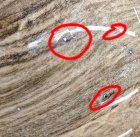I've got a 12" tall ambrosia maple end grain vessel that I finished in about 10 coats of lacquer. Then to finish the finish, I wet sanded with 600/800/1000/1500/2000. I then used both rubbing and then polishing compound to bring back the shine, and it's beautiful, except for a few small areas around some little worm holes whee I ended up sanding all the lacquer off. I've posted a cropped in pic with the areas circled in red the areas that range from about a 1/4 inch (the biggest area). down to a 1/16 inch strip (I've not yet finished cleaning up the leftover polishing compound in the worm holes).
What's the best way to remedy this? Spraying a light coat or 2 and then running some polishing compound over it after a few days? I'm a bit worried the over-spray is going to mess up a larger area of an otherwise perfect finish if I do this. Has anyone ever trying spraying a bit of lacquer into a small bowl then use a tiny paint brush to quickly apply some before it dries?
Thanks for any help,
Grey

What's the best way to remedy this? Spraying a light coat or 2 and then running some polishing compound over it after a few days? I'm a bit worried the over-spray is going to mess up a larger area of an otherwise perfect finish if I do this. Has anyone ever trying spraying a bit of lacquer into a small bowl then use a tiny paint brush to quickly apply some before it dries?
Thanks for any help,
Grey

Last edited:
